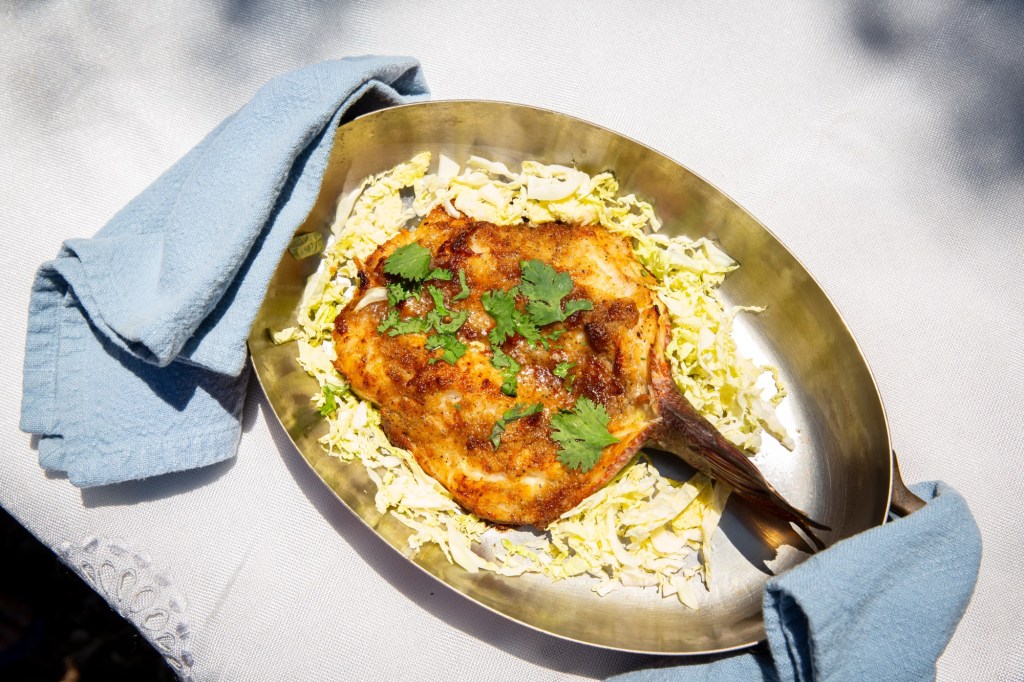For The Union-Tribune
Have you ever gone to your local fish market, spotted a beautiful, unfamiliar variety of locally caught fresh fish and realized you’d love to try it but haven’t a clue how to prepare it?
Or felt intimated by all the choices and thought fish, especially an unknown type, is too hard to cook? Or thought that cooking fish is best left to professional chefs?
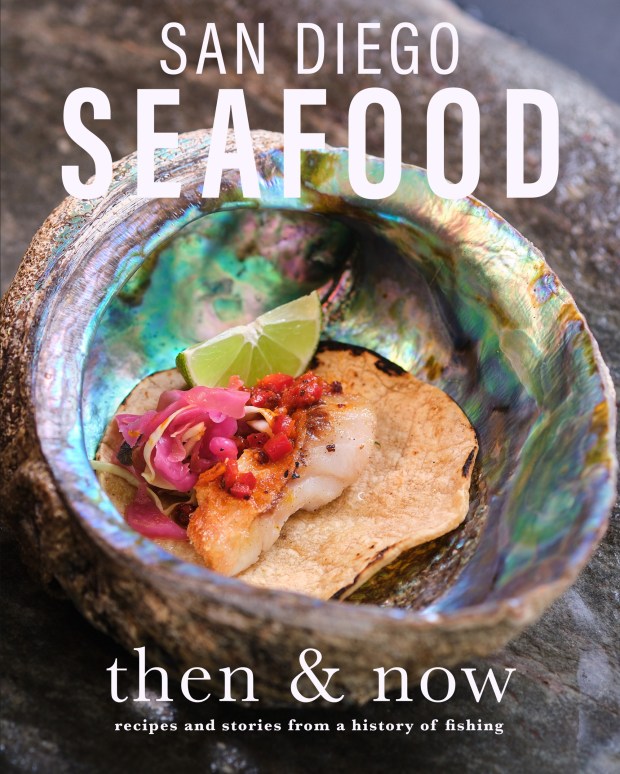 “San Diego Seafood Then & Now: Recipes and Stories From a History of Fishing” is published by Chula Vista-based Sunbelt Publications. (Chris Rov Costa)
“San Diego Seafood Then & Now: Recipes and Stories From a History of Fishing” is published by Chula Vista-based Sunbelt Publications. (Chris Rov Costa)
If so, the recently published “San Diego Seafood Then & Now: Recipes and Stories From a History of Fishing,” from Sunbelt Publications, is the cookbook for you. It’s more than a collection of recipes showcasing the diversity of local seafood. It also pulls together the rich history and recipes of San Diego’s fisheries, canneries and residents, from the Indigenous Kumeyaay to the many waves of immigrants who’ve fished and settled here, the first Spaniards through the Chinese, Japanese, Portuguese, Italian, Mexican, Filipino and more recent multicultural fishing communities who have molded our cuisine.
Each chapter, focusing on a different community, is illustrated with drawings and historical photographs drawn from collections including those of the Maritime Museum of San Diego and San Diego History Center.
Project leaders Theresa Sinicrope Talley, Ph.D., and Emily Miller of the California Sea Grant Extension Program at UCSD, which works with fisheries, coordinated a group of over 100 San Diegans, mostly volunteers — fishing families, chefs, home cooks, scholars, historians, fishery and coastal researchers, artists and photographers — to produce an exquisitely photographed and meticulously researched love letter to the unsung bounty of San Diego fisheries. The resulting book demonstrates how simple and easy it can be to cook fresh fish.
 Salvador Roberto Torres’ mural in Logan Heights, depicting cannery work, appears in the book. (Neva Sullaway)
Salvador Roberto Torres’ mural in Logan Heights, depicting cannery work, appears in the book. (Neva Sullaway)
The effort, Talley explained, emerged from the early COVID pandemic shutdowns of restaurants and many businesses. Fishermen were arriving in port with boat loads of fish and nowhere to sell it, while residents were experiencing high food insecurity. In 2020, she and chef Cynthia Quinoñes helped coordinate Fish to Families, a program spearheaded by local fishermen, including Peter Hallmay of the Tuna Harbor Dockside Market, and chefs who secured funding to buy fishermen’s surplus catch and provide it to commercial kitchens to create nutritious meals served through charitable organizations.
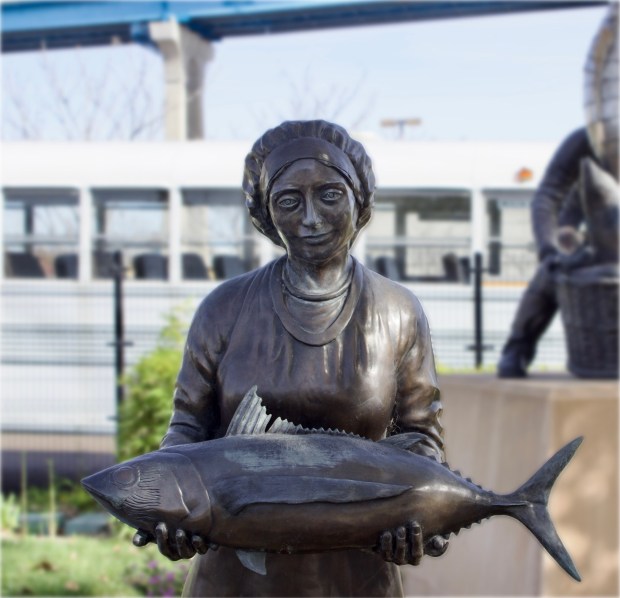 Also shown in the cookbook: A sculpture of a woman presenting an albacore tuna is at Parque del Sol in Logan Heights as part of “The Cannery Workers Tribute,” The permanent exhibition of mosaics, plaques and sculptural renditions memorializes a community legacy of seafood on the working waterfront. (Neva Sullaway)
Also shown in the cookbook: A sculpture of a woman presenting an albacore tuna is at Parque del Sol in Logan Heights as part of “The Cannery Workers Tribute,” The permanent exhibition of mosaics, plaques and sculptural renditions memorializes a community legacy of seafood on the working waterfront. (Neva Sullaway)
“What we learned was the chefs in these kitchens weren’t quite sure what to do with local seafood. They were unfamiliar with many species, this spiny rockfish or really big, round opah or flat angel shark. So they got together and tried to learn among themselves and teach each other how to process fish. Chef Cindy and I would lament that we needed a website with a few recipes and tips, maybe a little demo, outside where it’s safe to teach the kitchen staff and chefs how to work with local seafood,” Talley explained.
This lack of know-how extended to home cooks, they soon recognized, and plans for a cookbook began. Thanks to the generosity of 250 donors, including California Sea Grant, they raised enough money to publish the book, which is available for purchase at the Maritime Museum of San Diego (which inaugurated an updated San Diego fisheries exhibition to coincide with its publication), TunaVille Market, Sunbelt Publications and local bookstores.
“If I asked you your favorite seafood, what would you say? Most people would say shrimp, tuna and salmon. In San Diego, we do still have tuna, but we don’t catch salmon and we don’t have the Gulf-type shrimp they’re thinking of (but we do harvest spot or ridgeback prawns). We have a fishing industry that lands over 100 species a year,” Talley said.
In their introduction to the cookbook, Talley and Miller explain the two goals of the cookbook: “to connect people with San Diego’s fishing and seafood history” and to “demystify locally-landed seafood through its presentation in recipes that illustrate the variety and versatility of San Diego’s sustainable ocean bounty.”
The recipes show how to substitute different varieties for a recipe’s specified choice. For example, San Diego fishermen land over 50 varieties of rockfish from the region’s waters.
“If the fish you want isn’t available there are probably five other suitable species that are in season. If you don’t have halibut, then use any rockfish or white fish of similar fat content,” Talley said.
My favorite chapter is the first, “Demystifying Local Seafood,” which contains the best descriptions I’ve seen of how to buy fish, including how to determine fish freshness, select a variety for best flavor and texture for your recipe, “dress” or clean and scale whole fish and store, freeze and thaw frozen fish.
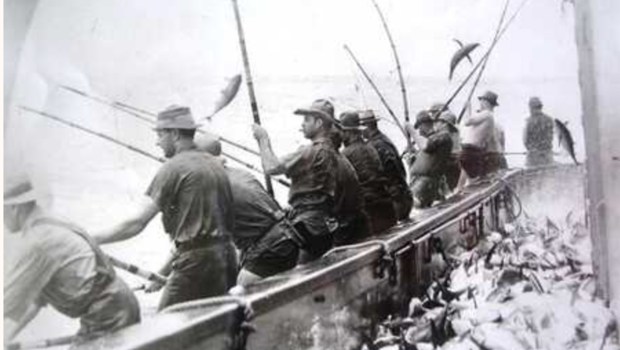 “Fishing from the racks” was a term from the era of tuna clippers — specialized fishing vessels equipped with platforms called “racks” that extended along the outside of the stern and port sides, which allowed fishermen to position themselves closer to the water and gain better leverage when lifting fish from the sea. (San Diego Maritime Museum)
“Fishing from the racks” was a term from the era of tuna clippers — specialized fishing vessels equipped with platforms called “racks” that extended along the outside of the stern and port sides, which allowed fishermen to position themselves closer to the water and gain better leverage when lifting fish from the sea. (San Diego Maritime Museum)
In addition, this chapter explains the benefits of buying local seafood, including supporting the survival of the local fishing industry while boosting the economy and making environmentally responsible choices.
Collecting recipes, Miller explained, during the height of the pandemic was challenging, but once fishing luminaries Tommy Gomes and Hallmay endorsed the project and provided their own favorite recipes, many prominent local chefs, fishing families and home cooks joined in, resulting in a diverse collection representative of San Diego’s melting pot.
Rarely seen in any cookbooks are recipes from the region’s native Kumeyaay culture, whose recipes are mostly handed down within families and tribes.
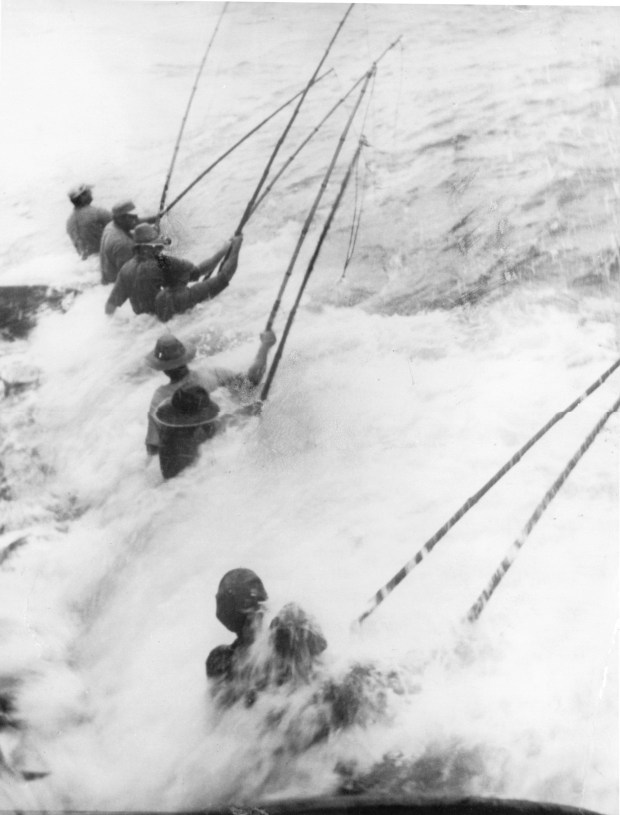 Tuna fishermen fishing from the racks wield bamboo poles and barbless hooks, an innovation introduced to the West Coast by the Japanese fishing community. The work could be perilous in blustery weather. (San Diego Maritime Museum)
Tuna fishermen fishing from the racks wield bamboo poles and barbless hooks, an innovation introduced to the West Coast by the Japanese fishing community. The work could be perilous in blustery weather. (San Diego Maritime Museum)
Heather Ponchetti Daly, Ph.D., a member of the Iipay Nation of Santa Ysabel and assistant professor of history at UCSD, collaborated with her colleagues Alexander Hunter, Ph.D., and Eva Trujillo to write the chapter on the Kumeyaay Nation history and their involvement with the ocean and fishing.
Although she didn’t grow up with a strong family tradition of eating fish, Daly loves to cook and created a class at UCSD on indigenous food justice and sovereignty, which includes a cooking component. She consulted with an anthropologist while choosing her ingredients to verify the use of crabs and bivalves before European contact.
“For our class, like this cookbook for fish, we’re using the materials that have always been here, but have gotten lost and we’re finding them again,” Daly said.
Miller, who does seafood education for California Sea Grant and grew up in a family that fished and previously worked as an observer on a commercial fishing vessel, stressed the importance of fish freshness.
“A fish that’s so fresh that the freshness is almost an ingredient in itself. You only need to cook it simply and it will be delicious,” she said.
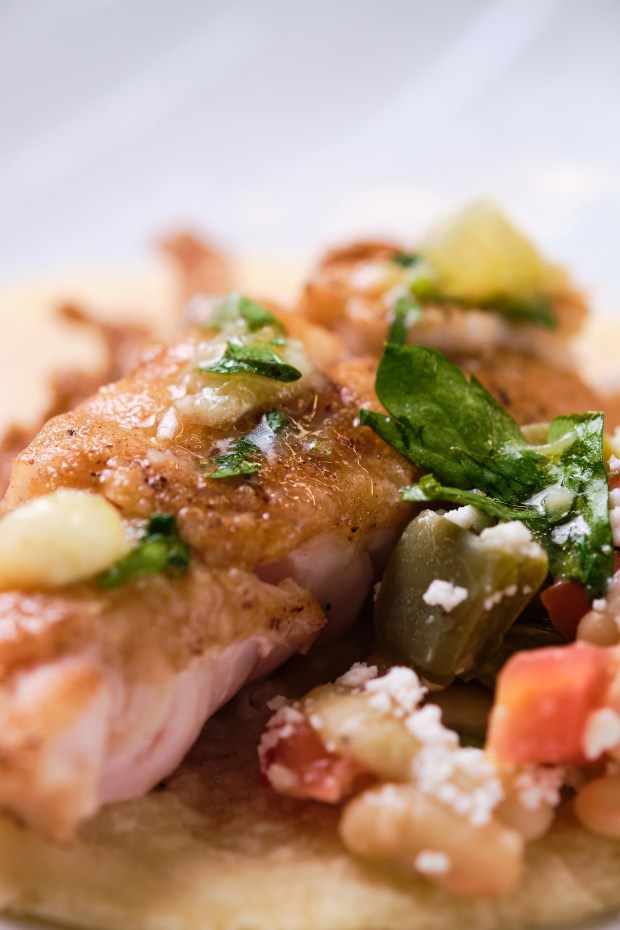 Pan-Fried Fish With Citrus Relish is placed in a tortilla, in a recipe by Heather Ponchetti Daly of the Iipay Nation of Santa Ysabel. (Chris Rov Costa)
Pan-Fried Fish With Citrus Relish is placed in a tortilla, in a recipe by Heather Ponchetti Daly of the Iipay Nation of Santa Ysabel. (Chris Rov Costa)
Pan-Fried Fish With Citrus Relish
Home chef Heather Ponchetti Daly, a member of the Iipay Nation of Santa Ysabel and assistant professor of history at UCSD, created this recipe mainly using ingredients available to the Kumeyaay pre-contact. If using California halibut, cook it slowly and carefully to avoid drying it out. It’s a lean and delicate fish that retains moisture when basted with fats during the cooking process or when poached or steamed.
Makes 4 servings
INGREDIENTS
Recommended fish: 4 (6-ounce) fillets of any local species, such as California halibut or other whitefish
For the citrus relish:
1 to 2 Meyer lemons, peeled and chopped
1 to 2 shallots, diced
1 tablespoon white wine vinegar
1 clove garlic, minced
2 tablespoons chives, minced
1 tablespoon parsley, minced
1/2 cup olive oil
Salt and pepper to taste
2 tablespoons lemon sorrel, minced (optional)
For preparing the fish:
1 cup vegetable oil
1 cup red or blue cornmeal
1 teaspoon salt
1 teaspoon pepper
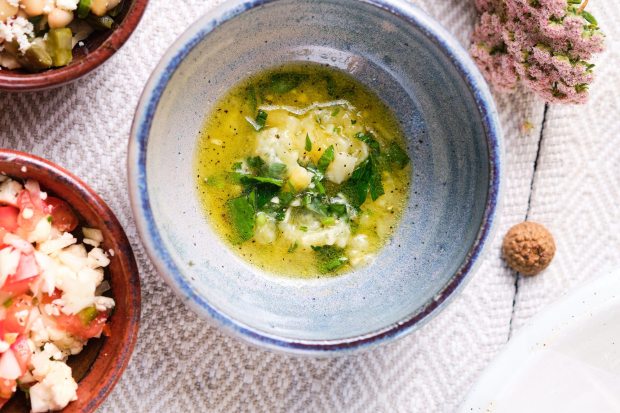 A zesty citrus relish is used to top the pan-fried fish. (Chris Rov Costa)
A zesty citrus relish is used to top the pan-fried fish. (Chris Rov Costa)
DIRECTIONS
1: Prepare citrus relish by combining all ingredients in a mixing bowl, and set aside while fish is pan-fried.
2: Heat vegetable oil in a large skillet over high heat. Evenly mix cornmeal and salt and pepper on a plate, then dredge fillets to coat both sides. Once oil is hot, fry fillets until golden brown on both sides.
3: Remove fillets from skillet and set aside on paper towels to drain.
4: Plate fillets and top with relish. Serve alone or with corn tortillas to eat taco-style.
Recipe by Heather Ponchetti Daly.
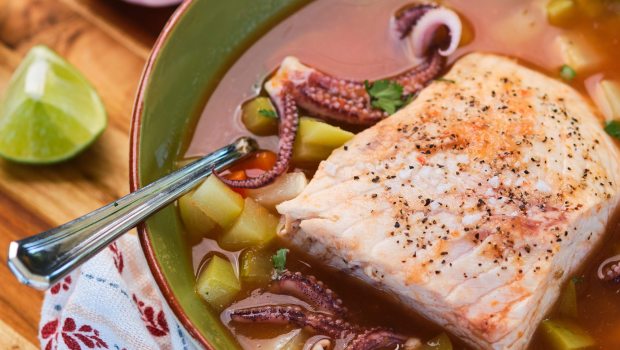 Xalapa-Style Seafood Soup, with recipe by chef Juan Pablo Sánchez, stems from regional cuisine in the Mexican state of Veracruz. (Chris Rov Costa)
Xalapa-Style Seafood Soup, with recipe by chef Juan Pablo Sánchez, stems from regional cuisine in the Mexican state of Veracruz. (Chris Rov Costa)
Xalapa-Style Seafood Soup
For the fish fillets, professional chef Juan Pablo Sánchez recommends using monchong (shown in the photo, also called sickle pomfret), lingcod, white seabass, California halibut, ocean whitefish, any rockfish or other white, flaky fish.
Makes 5 to 8 servings
INGREDIENTS
Seafood: 1 pound of spot prawn or ridgeback shrimp (peeled, deveined) or market squid (cleaned and cut into bite-size pieces)
2 fish fillets
1 carrot, diced
1 stalk of celery, minced
1 chayote squash, diced
4 tomatoes, roughly chopped
1 jalapeño pepper, coarsely chopped
1/2 onion, roughly chopped
4 garlic cloves
1/2 teaspoon olive oil
1/2 teaspoon chicken bouillon or stock powder
Salt, to taste
DIRECTIONS
1: Place chopped carrots, celery, and chayote squash in a medium pot. Fill the pot with water until veggies are just covered, and bring to a boil
2: In a separate pot, combine tomato, jalapeños, onion, garlic, olive oil and chicken bouillon. Add water until contents are just covered, and bring to a boil. Once the pot has reached boiling, remove from heat and blend contents into a puree.
3: Add tomato puree to carrots, celery and chayote, and let it reach a boil again. Add the fish fillets, spot prawn or squid, and cook for 5 minutes or until done. Serve immediately.
Recipe by chef Juan Pablo Sánchez.
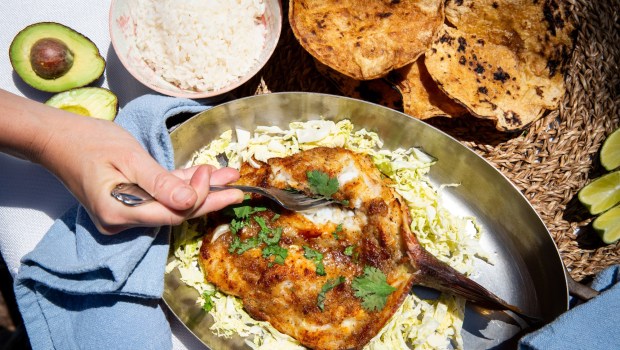 Mexipino-Style Local Fish, with recipe by Rudy P. Guevarra Jr., reflects his Mexican and Filipino heritage. (Oriana Poindexter)
Mexipino-Style Local Fish, with recipe by Rudy P. Guevarra Jr., reflects his Mexican and Filipino heritage. (Oriana Poindexter)
Mexipino-Style Local Fish
Many San Diego families are of mixed cultural heritage and their tables reflect that fusion. Home chef Rudy P. Guevarra Jr., professor of Asian Pacific American studies at Arizona State University commented, “This recipe reflects my Mexican and Filipino heritage and upbringing in National City. A butterflied, whole fish is enjoyed by both sides of my family, whether with rice or as tacos, with avocado, salsa, cilantro, and a squeeze of lime for each taco. This simple preparation is traditionally made with bangus, or milkfish, which is the national fish of the Philippines. Substitute California sheephead or ocean whitefish, because they are white-fleshed, firm, with fine-grained meat, similar to bangus.”
Makes 2 to 3 servings
INGREDIENTS
Fish: 2 pounds California sheephead or ocean whitefish, butterflied and bones removed (as much as possible)
6 cloves of garlic (minced)
1 tablespoon garlic powder
1/2 teaspoon kosher or sea salt
1/4 teaspoon black pepper
2 tablespoons olive oil
1 teaspoon rice vinegar
Kosher or sea salt, to taste, for finishing
DIRECTIONS
1: Combine all ingredients except fish into a small bowl and mix until they form a paste.
2: Spread the mixture onto the butterflied fillets and set aside to marinate in the refrigerator.
3: After two hours of marinating, remove fish from refrigerator and place on a foil-lined baking sheet until it has returned to room temperature (around 15 minutes).
4: Broil fish in the oven for 5 to 7 minutes, or until it has a slight char.
5: Turn off the broiler and bake for at 350 degrees for 25 to 30 minutes or until fish is cooked all the way through. Remove from oven and let rest for 5 minutes.
6: Sprinkle a little finishing salt over the entire fish, and serve with rice, or with tortillas and toppings to make tacos
Recipe by Rudy P. Guevarra Jr.
All recipes adapted from “San Diego Seafood Then & Now: Recipes and Stories From a HIstory of Fishing” (May 2025, Sunbelt Publications).
